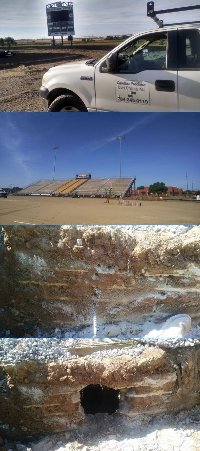The core drilling job in South Carolina.
Recently we were called to do a core drilling job in Bennettsville, South Carolina for a local artificial turf contractor that has been a customer of ours for more than 8 years. The order for core drill holes was as this. The Customer needs 3 10-inch holes for an eight-inch schedule forty PVC drainage pipe. He also needs 1 fourteen inch hole for a 12-inch drainage pipe. Both of these sizes of pipe would be depositing their waste load into some brick drainage water basins that had been installed in the Marlboro High School football field since it was built back in the latter part of the 20th century.
It turns out that after arrival and some inspection that the brick water basins were too decrypted to attach our trusty rig to the side of the basin with any type of concrete or masonry anchors that would hold it on the basin wall while the drilling was being done.
The decision to chip the hole out with a hammer drill.
Not all core drill operators core drill all-day, or everyday on any given job. Many times the hole that is needed is located in less than desirable core drilling places and not always can one accomplish the mission at hand with by core drilling. Sometimes you have to get your hammer drill out and do some chipping. Especially if the brick that you are about to try to penetrate is old, terribly falling apart, or high on the wall and tough to reach with a core drilling rig just won't go.
So how do you go about hammer drilling a hole in a brick structure?
List of tools you may need
- Rotary SDS style hammer drill that hammer drilling and chips
- A good SDS 1/2 inch or smaller diameter hammer drill bit.
- A good heavy duty hammer
- A steel-concrete chisel
- Maybe a tape measure
- brush, Rag or shop vac for the dust
- A pair of good gloves that can take digging in brick
You start by making a pattern
of the size of opening that you want to make in the brick structure. Any type of pattern is acceptable but if you have to fill in around the material that is going to be inserted into the hole then you might not want to make it larger than is needed.
Then take your SDS masonry drill bit and drill around the pattern you make every 1/2" to 1". Drill the holes all the way through and as straight as you can so that your hole will be better formed and it won't look like this is the first hole that you have chipped out of a brick wall.
Make as many holes as you can where the holes in needed. Larger holes and patterns call for more holes to be drilled so the brick will chip or knock out more easily.
Once you are happy with how many holes that you have drilled into the brick then switch your hammer drill to chipping mode and start chipping. On occasion, you may have to take your heavy hammer and give the spot a few good whacks to loosen up the brick so it will fall out more readily. When chipping out brick it it never going to be the prettiest hole in the world so if the hole is to covered up then don't worry about it.

